We’ve all heard of polar bears and grizzly bears, but if you had to guess which one was the more dangerous species, what answer would you give? The truth is, with climates rapidly changing there have been showdowns that pit polar bears vs. grizzly bears, and one of the species has come out on top. Let’s dive into the differences between polar bears and grizzly bears and then see which one of these animals is the top dog in a fight.
Polar Bear vs. Grizzly Bear

Its a showdown between bears!
©Tony Campbell/Shutterstock.com
Polar bears and grizzly bears are both mammals in the Ursidae family. They’re both extremely large bears, although polar bears take the crown of being the largest bear species. In fact, polar bears stand out in a number of ways:
- Polar bears are generally more aggressive than grizzly bears. Example: in the northerly Norwegian islands of Svalbard, there is a significant polar bear population. They’re aggressive enough that when outside settlements it’s mandatory to carry firearms to scare off polar bears.
- Polar bears have higher metabolisms: Here’s a shocking fact, grizzly bears don’t eat much meat. Just 10% of their diet is meat as they prefer berries and flowering plants. Compare this to polar bears who almost exclusively eat meat.
- Polar bears don’t hibernate: Grizzly bears will fatten up for long winter hibernations. Polar bears welcome the harshest winter conditions and continue hunting year-round.
Add it up and you have polar bears being more aggressive, eating almost a diet almost exclusively composed of meat while grizzly bears forage berries, and hunting through the worst of the winter while grizzly bears nap away.
Sounds like it’d be no contest that a polar bear would win in a fight, right?
Who Would Win in a Fight Between Grizzly and Polar Bears?
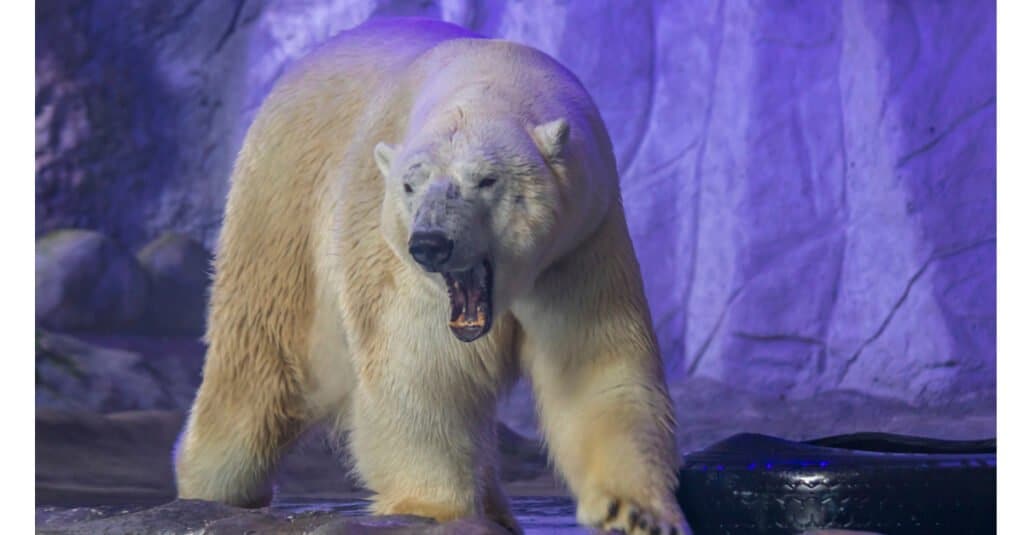
Polar bears are fierce, but will they fight?
©imperio10/Shutterstock.com
The answer of who reigns supreme in a fight pitting polar bears vs. grizzly bears may surprise you.
A study from 2015 looked at interactions between grizzly and polar bears. Historically, grizzly and polar bear territories haven’t overlapped. However, with changing climates extending grizzly ranges north, the two species are increasingly encountering one another. Especially along Alaska’s north coast, events like beached whales create environments where the two bears will compete for very large meals.
Here’s a sample directly from the study.
Our results indicate that grizzly bears are socially dominant during interspecific competition with polar bears for marine mammal carcasses during autumn.
Journal of Mammalogy, 24 November 2015
Put more bluntly, when polar bears and grizzly bears are both competing for food, it is the polar bears that are more likely to walk away from conflict and leave the prize for grizzly bears.
The bottom line: in a fight between a polar bear and a grizzly bear, the grizzly bear reigns supreme.
Advantages in a Fight Between Grizzly Bears and Polar Bears
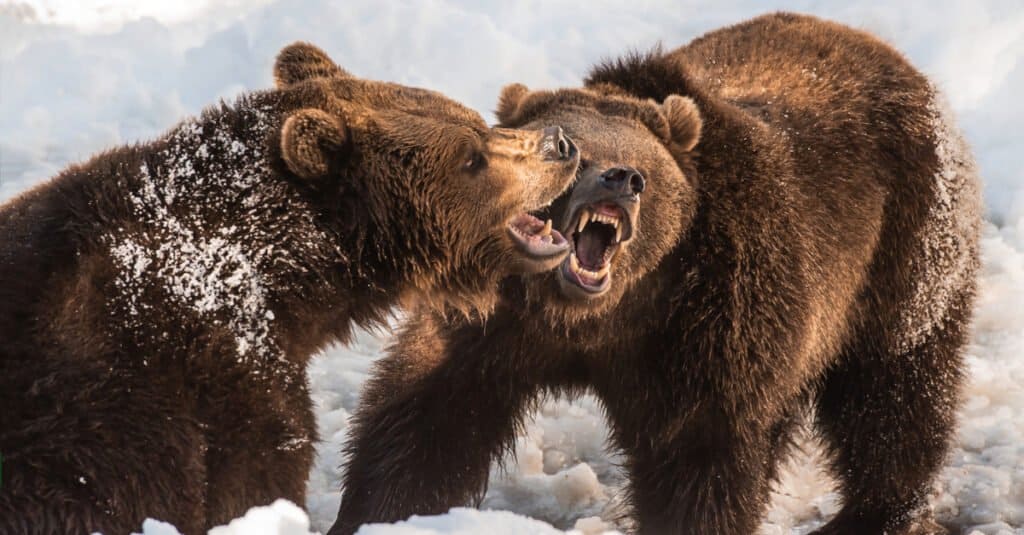
Grizzlies are extremely aggressive.
©Alexandra Giese/Shutterstock.com
We’ve seen the study that says polar bears are more likely to concede prey to grizzly bears, but if the two were to battle, what advantages does each species have?
After all, polar bears may simply be more willing to concede prey to save precious calories from fighting. In the event an actual fight took place, results may be different.
So, which species has the upper hand?
Polar bears are generally larger. Male polar bears weigh an average of 770 to 1,500 pounds. The largest subspecies of brown bears, the Kodiak bear, has an average weight of 660 to 1,320 pounds. Male grizzly bears whose range overlaps with polar bears average closer to 400 to 790 pounds. The largest polar bear ever recorded weighed 2,209 pounds, while few grizzly bears on record weigh more than 1,700 pounds.
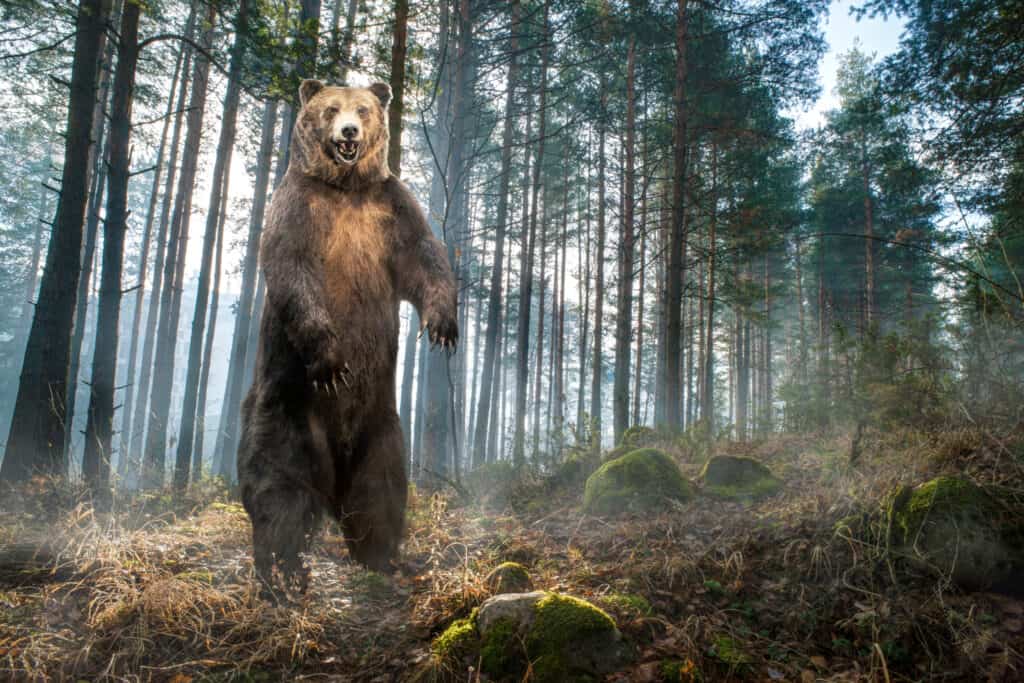
Grizzly bears know how to strike fear – even polar bears are intimidated!
©Degimages/Shutterstock.com
Polar bears have enormous paws that help them walk along the ice. This makes their claws shorter and sharper. If the two were hitting each other with their claws, it’s likely the brown bear would have the advantage as their claws are more adapted to swiping.
If a battle between grizzlies and polar bears turned into a wrestling match, the advantage could swing to polar bears. When polar bear males battle (playfully or not), they tend to wrestle and bite at each other’s necks.
Is it Normal for Grizzlies to Attack Polar Bears?
Encounters between grizzlies and polar bears have been reported in past literature; in these encounters, grizzly bears killed denning female polar bears while at a significant size disadvantage.
Make Love Not War: The Emergence of Pizzly Bears
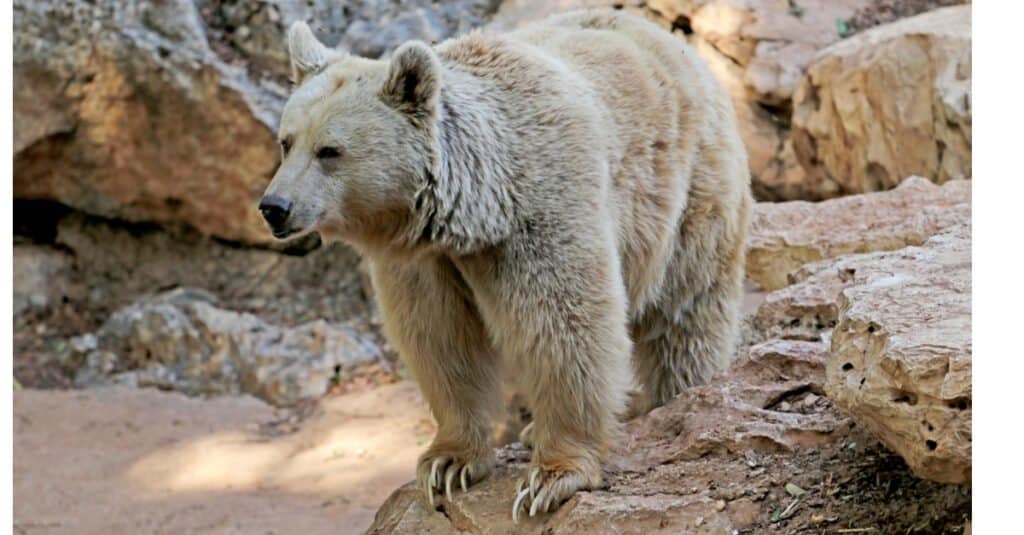
Pizzly bears have long claws and whiter coats
©Yurii 1111/Shutterstock.com
However, all the talk about whether a grizzly bear or polar bear would win in a fight might be missing the mark. In 2006 an odd-looking polar bear was shot in Canada. The bear was white but had longer claws and other features that were similar to grizzly bears. DNA analysis quickly confirmed that the bear’s father was a brown bear and its mother a polar bear.
The result: a pizzly bear. A hybrid animal that’s part grizzly and part polar bear.
The two species can mate because they’re genetically very similar. In recent years, more than a half dozen pizzly bears have been discovered across Alaska and Canada. Their continued discovery shows that the range of the two species is increasingly overlapping, and they’re choosing to make love rather than war.
Comparing Polar Bears vs. Grizzly Bears
| Polar Bear | Grizzly Bear | |
| Heaviest Recorded | 2,209 pounds | 1,700+ pounds |
| Average Length of Mature Male | 8-8.4 feet | >7-10 feet |
| The main method of fighting | Wrestling and biting at the neck | Swiping with front claws |
| Average weight | 900-1,500 pounds | 400-790 pounds |
| Lifespan | 25-30 years | 20-25 years |
Polar Bear vs. Grizzly Bears: The Main Differences Explained
Let’s examine the key differences between grizzly and polar bears.
What is a polar bear?
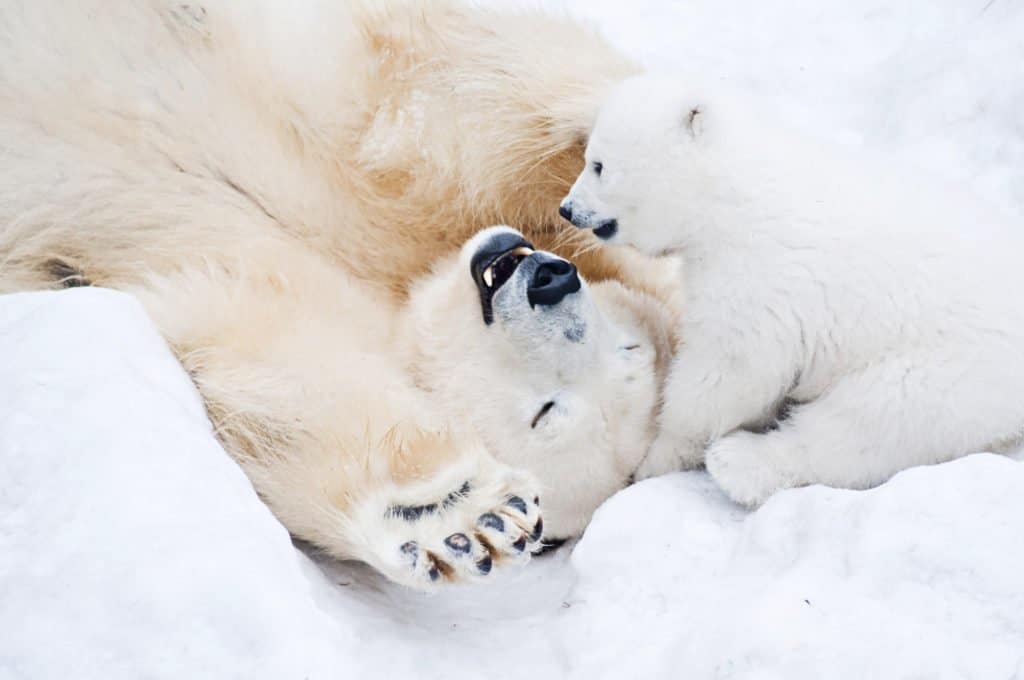
A polar bear cub with its mom
©Lamberrto/Shutterstock.com
A polar bear is a species of large-bodied bear that ranges from Greenland and Svalbard (Norway’s arctic archipelago) in the north to Alaska in the south, although they are most common in and around sea ice in the Arctic Ocean and in the Northwest Passage, to the east of Russia, Canada, and Greenland. Although all polar bears have white fur, they vary in color due to varying melanin concentrations in their fur. It is also said that polar bear fur has no color; instead, it reflects the colors of its surroundings.
Polar bears live on land, too, but not all polar bears live in Arctic regions. A rare type of polar bear lives along the coast of Russia near the Sea of Okhotsk, the Bering Strait, and the Chukchi Sea, which is also sometimes called the “polar bear’s backyard.” Polar bears live in Arctic regions, but they do come down to the lower latitudes in the winter to forage on the sea ice and fish. Polar bears are the largest bear species on average and are born with thick layers of fat, which they need to keep warm.
What is a grizzly bear?
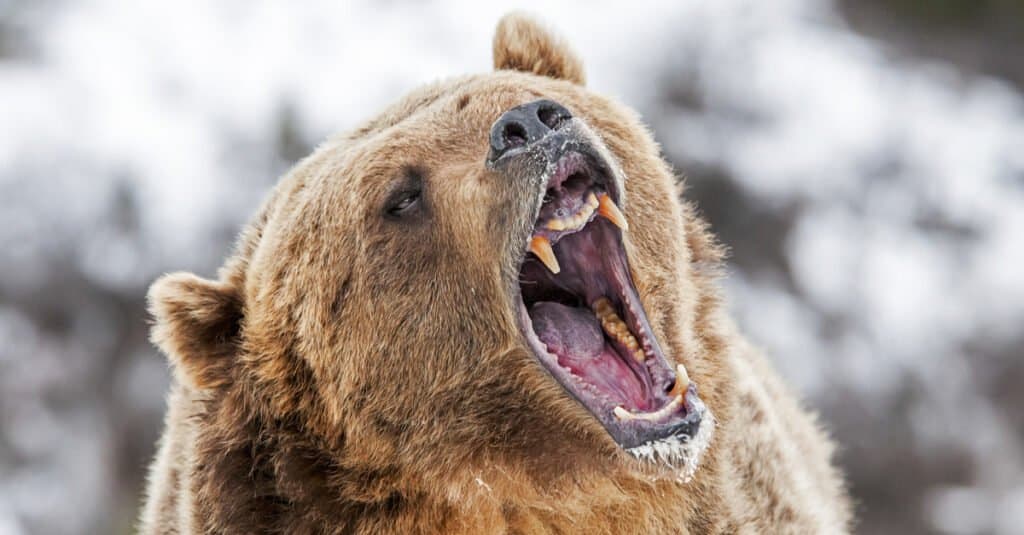
Grizzly bears feast on everything from
salmon
and trout to large animals such as moose and elk.
©Scott E Read/Shutterstock.com
Grizzly bears are found throughout much of North America and Alaska, where the winters are cold. The species will build up their body fat in preparation for the winter season. In winter they will hibernate for up to seven months, not even waking to go to the bathroom. The bear will prepare by digging a hole for their den, usually on a hillside. Once inside, they slow down their body functions such as heart rate, temperature, and metabolism. This allows the fat reserves to last longer. If a female grizzly is pregnant she will give birth in the den, and nurse her cubs until spring and the cubs are old enough to explore outside the den.
Polar Bear Diet vs. Grizzly Bear Diet
Polar bears eat primarily seals. Although these seals are numerous throughout the Arctic Circle, many polar bears avoid moving too far north to capture them. The reason for this is that the ocean around the polar bear’s natural habitat is ice-covered during the winter. Without a healthy seal population to hunt, these polar bears are forced to eat other prey such as walrus or even beluga whales. Because polar bears are very dependent on seals for their diet, seals have evolved to be wary of approaching polar bear dens during the spring and summer months.
Grizzly bears are opportunistic feeders. They eat almost anything they can get their paws on, including carrion, insects, eggs, fish, rodents, ground squirrels, carrion, moose, elk, caribou, and deer. They will also eat many types of plants, including those with fleshy roots, fruits, berries, and grasses. In some areas of Alaska, they’ve even been known to attack cars when drivers do not slow down quickly enough.
Habitat of Grizzly Bears vs. Polar Bears
Grizzly bears generally live further south than the Arctic regions of polar bears. Today they live across much of Western Canada and Alaska. Polar bears, on the other hand, live on the northern edges of North America and have a range that extends all the way to the North Pole. Since polar bears’ main diet is seals, they remain close to the water and rarely travel inland.
On average, polar bears inhabit and are found in the ocean’s Arctic waters, while grizzlies stay in terrestrial regions.
Are Polar Endangered Species?

Polar bears are threatened by climate change
©Louise Ekeblad/Shutterstock.com
Polar bears are classified as a vulnerable species by the International Union for Conservation of Nature (IUCN). It is estimated that there are only about 22,000-31,000 polar bears left in the wild. These majestic creatures face many threats, including global climate change and loss of sea ice habitat. Pollution from oil and gas extraction also negatively affects their food sources, such as seals. In addition to this, hunting has caused a significant decrease in their population over time. To protect these animals, it is important that conservation efforts continue in order to reduce all human-related causes of harm to polar bear habitats and populations worldwide.
Are Grizzly Bears Endangered Species?
Grizzly bears are classified as a threatened species in the lower 48 states of the United States and an endangered species in Canada. While their exact numbers aren’t known, it is estimated that there are only around 1,400 grizzlies left in all of North America. In addition to habitat loss and fragmentation due to human encroachment on their territory, grizzly bears face additional threats such as poaching and legal trophy hunting. Climate change has also caused changes to food availability which affects grizzly bear populations. Conservation efforts have been put into place to try and protect remaining grizzly bear habitats, but they continue to be at risk from human activity.
The photo featured at the top of this post is ©
Thank you for reading! Have some feedback for us? Contact the AZ Animals editorial team.






